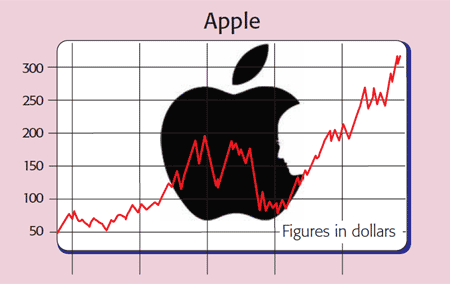
What does the company do?
Apple designs and sells consumer technology products. It sells a range of Mac personal computers with its OS X operating system, along with its iLife and iWork software. Its digital music business centres on the iPod music player and its iTunes online music store. The iPhone, App store, and iPad tablet computer comprise Apple’s mobile media offering. It also has a network of high-street stores that sells its products.
What is the history?
Apple was formed in 1976 when Steve Wozniak and Steve Jobs began producing a micro-computer in Jobs’s garage. The Apple II computer was initially popular with programmers, but later became entrenched in the small business and education sectors. The first Macintosh computer, launched in 1984, failed to meet sales targets, leading to the ousting of Jobs from the company. Under CEO John Sculley, the Macintosh was improved and Apple came to lead the publishing and graphics markets, but in the 1990s, it struggled against Microsoft and the PC. In 1997, Jobs returned and turned Apple around, introducing the iMac computer (1998), iPod music player (2001), iPhone (2007) and the iPad (2010). Profits boomed and Apple become one of the world’s most valuable companies, with sales of $65bn in 2010.
Who runs it?
Tim Cook succeeded Jobs as chief executive in August 2011, having previously been chief operating officer and head of Apple’s Macintosh division. He was paid $5.8m in 2010. Other key people include Jonathan Ive, leader of the company’s design team, and Philip Schiller, head of product marketing.
How’s trading?
Third-quarter results to June 2011 saw revenues grow by 82% to $28.57bn. Net profits rose 125% to $7.31bn; iPhone sales grew by 142% to 20.3 million units (MU); iPad sales rose 183% to 9.25 MU; sales of Macs grew by 14% to 3.95 MU. But iPod sales fell 20% to 7.54m. The firm has a huge cash pile of $76bn.
What’s the outlook?
Strong demand for iPhones and iPads should see profits continue to grow. How the company will fare in the longer run depends on how Apple – without Jobs, who died last week – continues to innovate, given short product life cycles and growing rivalry. Its operating profit margins are high – 31.4% against just 11.8% in 2005. Amazon, Google and Samsung all want a bigger piece of Apple’s markets, which could threaten prices.
The analysts
Of the 54 analysts surveyed by Bloomberg, 49 say “buy” and five “hold”. There are no “sell” recommendations. The average price target is $499 – 35% above the current share price. Most bullish is Ticonderoga Securities, with a $666 price target, whereas Scotia Capital is most bearish with a $440 target. Our view: at 11.3 times 2012 earnings per share, Apple looks cheap, but uncertainty around the long-term sustainability of margins makes it a cautious ‘hold’.
The numbers
Stockmarket code: AAPL
Share price $369.80
Market cap: $342.8bn
Net assets (June 2011) $69.3bn
Net cash (June 2011) $76.1bn
P/E (September 2012) 11.3x
Yield (prospective) 0%
Directors’ dealings
There has been no major net buying of shares by Apple directors during the last year and a small amount of net selling.
Chief executive Tim Cook’s shareholding is worth just over $5m at the current share price. The directors’ shareholdings are shown below, and their dealings in the chart on the right.
Director and shares held
T Cook: 13,754
S Forstall: 2,925
R Johnson: 232,875
R Mansfield: 501
P Oppenheimer: 5,580
P Schiller: 256
B Serlet: 111,309
B Sewell: 70
J Williams: 213